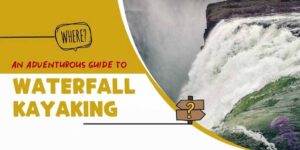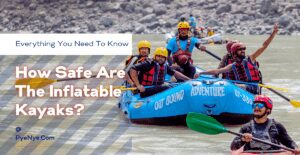Whitewater kayaking is the best way for getting started with kayaking. It has started around four thousand years ago. Mainly, Eskimos used it as a way of their transportation. Whitewater kayaking means to kayak on whitewater like; rivers, waterfalls, or lakes. Here we are presenting complete guidelines for whitewater kayaking for beginners.
People all over the world are involved with whitewater kayaking. It’s a wonderful way of recreation, pleasure, leisure activity, exercise, or meditation. Therefore, whitewater kayaking is worth learning for beginners.
The extreme and calm Water-flow will give us a lot of thrilling. This fulfills our minds with happiness. Overall, kayaking in the whitewater is a great way of entertainment.
PyeNye Blog

Here are some frequently asked questions on whitewater kayaking for beginners;
Like other sports, white water kayaking is not completely free from some risks. The risks are sun exposure, sunstroke, sunburn, dehydration, fast paddling, etc. Without preparations, this may be harmful. On the other hand, most of them have prevention. There are some ways out of danger. Firstly, it’s all about practicing. Be aware of safety. Get the weather news. Plan well the trip. Try easy kayaking. And concentrate on the water flow.
Starting with the whitewater is the best choice for beginners. It’s easy to begin. And needs less experience. We need basic items like; a kayak, paddle, PFD, dry bag, footwear, gloves, etc. Here we have 9 steps for starting whitewater kayaking. The first thing is all about the training. Start by group kayaking. Above all, try to maintain balance. And cope with the water.
Firstly, we need proper training for whitewater kayaking. There are two different checklists of equipment for getting started with whitewater kayaking. The first one is about the essentials. In this list, we need an easy and comfortable kayak. Then we should value a suitable paddle, life vest, etc. At the other checklist, we need to have some gear for accelerating the journey.
Here we need dry bags, suitable adjustments, perfect water shoes, gloves for our hands, dry storage, first aid tools, dry or wet suit, enough food, water, map. Besides, we need accessories according to our purposes of kayaking. It means when we are going fishing we need fishing gear.
And when we’re going camping we need kayak camping gear. It changes with the purposes. After some practice, we would realize it.
According to the purpose, there are some different types of whitewater kayaking. In a brief, there are six different types of whitewater kayaking. These are playboating, river running, down boating, etc. In the guide, we have presented everything about the different types of whitewater kayaking. For river kayaking tips, you can have a look at the blog post.
Let’s begin the guide with the different types of whitewater kayaking;
Jump To A Section
6 Different Types Of Whitewater Kayaking
Today, whitewater kayaking has become one of the most populous water adventures. A huge number of outdoors lovers get involved in whitewater kayaking. Thereby, there are different types of kayaking in the whitewater.
We can categorize almost six types of whitewater kayaking.

According to the movement, purposes of kayaking, and the different kayak boats, we can categorize whitewater kayaking. The different types of whitewater kayaking are below;
Whitewater kayaking as River running method
It is the most artful way of white water kayaking. The important matter is that in this way the kayakers can take different challenges, difficulties, expressions, or competitions in their own way. The whitewater kayakers of the USA and UK use the river running method on different events as well as for freestyle. Here is a compilation of Green River kayaking facts, you’ll enjoy this.
Whitewater kayaking as Squirt boating method
The main feature of squirt boat kayaking is that usually, it needs low-volume boats. The paddlers choose their boat as their preference, weight, or personal paddling method.
Whitewater kayaking as playboating
People use playboating kayaks for different acrobats, artistic styles, or gymnastic styles for kayaking. Playboating kayakers usually stay on one side or one place of the river. And perform kayaking against the extreme flow of the river. Besides, and perform different maneuvers. Hudson River kayaking can be a good example here.
Whitewater kayaking as Creeking
Creeking is a rapid and difficult technique of kayaking. Generally, experienced kayakers used this creeking method. Kayakers have to kayak in a high volume of whitewater if they want to perform creeking. Above all, it’s one of the higher and extreme parts of kayaking.
Whitewater kayaking as Slalom
Slalom is a whitewater kayaking that is usually used in various competitions such as Olympic Games. However, the kayakers use different styles and attempt to kayak as fast as possible. The kayaks of slalom kayaking should be lightweight, fast speed, and made with plastic or fiber.
Whitewater kayaking as Downriver Boating
Downriver boating kayaks are generally used for the level of comfort and control of the kayakers. The main feature of this kayak is that the beginners can track well and remain stable on the water.
Whitewater kayaking Basics For Beginners
As we mentioned before, whitewater kayaking is the best way for getting started on your journey with kayaking. According to The American Whitewater Organization,
More than half of all the American whitewater have a difficulty of beginners’ and average level.
The American Whitewater Organization
However, there are some basics for whitewater kayaking. We need to get in touch with the basic guidelines from the very beginning of our journey.
Physical movements work as exercise during the time of whitewater kayaking. Beginners will feel the positivity of these different movements of whitewater kayaking after a certain period of time. This is also a way of mind refreshment.
The 5 Basics Of Whitewater Kayaking
In the 5 basics, in this section, we are sharing the essential lessons for kayaking. These are; moving the paddle in “S” style, positions for kayaking, moving with your kayak, and raising the kayak. However, focus on the training. Point out your best zone. Perform with the basics. Besides, try to cope up with the water.

Move the paddle-like “S” style
Stroke the paddle-like “S” style. Hold the paddle strongly. It’s easier to stroke the paddle. And you can stroke in any direction. This also allows to stroke back.
However, it will help to promote your blood circulation system. Reduces the pain in the arms and muscles. As well as strengthen our elbow and wrist. So beginners should try to perform the different easy maneuvers with the paddle at the time of their white water kayaking.
Should paddle in the proper position
It is a necessary thing. kayakers should learn to sit and paddle in a proper position. Meanwhile, try to make it better. Whitewater is mostly calm and quiet, they should learn to kayak in the proper position.
Move forward with paddling
Concentrate on your kayaking. And focus on the next stroke. On the other hand, you need to hold the paddle vertically on the forwarding stroke. So, the whole attention should be given there and enjoy the whole moment.
Raising the kayaks
In training, a beginner should also learn to rise the running kayaks on a waterfall. Besides, practicing in a heavy water flow will develop your kayaking skills. In kayaking terms, we call this movement “Boofing.” Beginners should make close contact with the water at the time of learning boofing. They also have to learn how to manage and avoid all risks. But, beginners will get a top-level of enjoyment on the time of boofing.
Learn the backstrokes
Back strokes are a vital thing. Therefore, we have to learn to stroke back. It is not a difficult thing. You can use the same “S” style. Turn your shoulder back, and stroke from your hip side. Paddle reverse from your hip to your knees. It is also known as reverse paddling. Above all, the back of the paddle is designed for reverse paddling.
Backward paddling is a simple thing. However, it is the only way to paddle back. During your kayaking, you will face different situations. Therefore, learning back to paddling is a must.
Categorizing Skills For Beginners Whitewater Kayaking
We need to understand our skills. This will help our learnings. As soon as we categorize our skills we can accelerate our training. Then we can better outline our training. On the other hand, we need to understand the rule and regulations as faster as we can. In this blog post, we have presented “The 7 Rules For Freshwater Kayaking And Kayak Fishing”. This will boost up your training.
For making the whole thing easy, we need to train ourselves according to our skill level. In short, we can categorize beginners into three levels. These are;
- Beginner: Class 1 kayaker. They have only preliminary knowledge.
- Novice: Class 2 kayaker. They know the basic skills.
- Intermediate: Class 3 kayaker. They are experienced with all techniques of white water kayaking.
9 Lessons For Whitewater Kayaking For The Beginners
A complete lesson is essential for making your journey safe and enjoyable in the whitewater. We suggest practicing for few sessions with groups of friends. This is the very beginning part of the whole lesson. While you are going through this stage, try to develop the beginning techniques.
Beginners should maintain the following regulations to learn kayaking in the whitewater;
Choose a lightweight kayak
It’s the very beginning part of your journey with kayaking. Select a lightweight kayak for practice. This will help you learn things easier. Thereby, some training like re-entering the kayak, rolling, etc. would become more tranquil to learn.
Getting started with whitewater kayaking
In the beginning, try to take good training and assessment from experienced kayakers. Besides, you need to practice the lessons for a few sessions to develop your kayaking.
You can also share exclusive memories or wonderful stories with your family or friends. Thus, you will find inspiration from them.
If can try kayaking on the flatwater first. And after a few sessions, you would be able to paddle according to your comfort.
Learn to keep your feet straight
Try to keep your feet straight ahead from the very early sessions of your whitewater kayak learning. This will help you maintain balance while you are on the kayak.
Grip your paddle well
Grip your paddle well. Then, try to stroke the paddle in the right direction. Moreover, you should always focus on moving forward.
Learn to stroke the paddle
Learn to stroke the paddle in “S” style. It’s like the shape of 8. This is easier to learn. This is easier to learn.
And practice moving the paddle in every direction. In this case, the more you practice the easier your kayaking becomes.
Understand the water levels
Do not mess with the water levels. The more you study the water the more you get better with kayaking. The water level is one of the vital facts in kayaking.
When you are going for the first journey, make sure the water level is low, calm, and quiet. you can also try kayaking as an exercise. However, you would become comfortable with different water levels after a few sessions of kayaking.
Try not to practice some techniques at the beginning stage
Try not to practice some techniques at the very beginning stage. Moreover, such moves and techniques may be difficult and risky for beginners.
After categorizing your paddling skills, practice different techniques according to your kayaking experience. And the other important factor is proper guidance. We recommend not practicing techniques like boofing, high brace, backstroke at the very beginning level.
As soon as you become comfortable with whitewater kayaking you can maintain a schedule of practicing for such techniques.
Practice with friends
Beginners should practice kayaking in a friendly environment. As well as you should not go through any thrilling experience at the very beginning level.
As well as, do not take kayaking as extreme outdoor activity or typical exercise. Let your kayaking be a way of meditation, enthusiasm, or recreational activity.
Be patient and keep practicing
Lastly, patience is a big factor in learning kayaking. You should always keep learning different techniques. Determine your skill level and create a love for whitewater kayaking.
Always keep practicing. Thereby, you would become successful in learning whitewater kayaking as a beginner.
10 Tips For Mastering The Whitewater Kayaking
Whitewater kayaking will definitely become a more recreational activity from the beginning level if you perform it properly. Firstly, you have to know the methods. Then you can easily choose the best one for you. This will reduce the difficulties. Similarly, it will make your kayaking easy.
Besides, in this article, we have tips for easy kayaking. This will help your learning. Always concentrate on your moves. Try to understand the water. Above all, learn to deal with the water types.
In our blog, we have an enormous collection of tips that will simplify your kayaking. Besides, here are some tips for beginners:
- Pay your attention to kayaking. The more you concentrate the better you learn.
- Don’t go hurry at the beginning. Learn each kayaking and paddling style carefully.
- Try to feel the real physical and mental pleasure and love the exercise.
- You will have to decide that how much you will raise your gear on the water at the beginning level according to your experience. Sometimes high gear will make your journey enjoyable on high turbulence of water, or sometimes low or adequate gear will give you peace and pleasure in the calm and quiet flow of water.
- Sometimes at the beginning level, some people might discourage you by saying that it is a very risky or daring task. But do not listen to anyone. Just listen to your mind. If your heart is attracted by the white water, then go through this with kayaking.
- It will seem to be a little bit difficult for you at the beginning level. But you should not give up and keep trying. After a certain period of time, you will love it more than any other sports or exercise around you. Just keep continuing the learning.
- You may feel uneasy with the water of the river at the beginning level. But once you started this, you will feel if so more enthusiastic. Kayaking will make a chance for you to create a friendship with white water. You will enjoy every moment of kayaking. Also, the water lover will never give up if any severe problem could happen.
- Follow the guideline of your mentor. Enrich your experience and skill.
- Never get too excited or scared.
- Perform kayaking as a way of exercise and recreation. Therefore, in your kayaking, you will put all your ego and pain underwater.
Safety Guidelines For Beginners Whitewater Kayaking
Safeties are a vital issue for any kind of adventure. Honestly, there is not a single outdoor adventure that is totally free from risks. On the other hand, if there is no risk there is no adventure!
Therefore, we need to prepare ourselves well. There is always some way out of the risks. Moreover, it is necessary to practice kayaking safety lessons properly. These are like the “keys” behind every hassle-free kayaking experience.
Hence, concerning the risk factors, we have prepared complete safety guidelines. The following safety guidelines will help you have the best whitewater kayaking experience.
- Never forget your live vest (PFD). It’s essential. Above all, PFD should always be at the top of your kayaking checklist.
- Sunstroke is another problem. Do not go kayaking in the mid of the day. Keep enough water with you. Besides, the heat from the sun can also cause sunburn. Use sunscreen before kayaking.
- The extreme heat of the sun can also cause dehydration, confusion, dizziness, and eyesight problem and beginners cannot tolerate them easily. So the kayakers should carry enough drinking water and glucose with them. They also should wear water sunglasses on their eyes.
- Sometimes storms and lightning can cause fear for beginners. But white water means rivers or lakes. So they will go in a safe position.
- Coldwater can create hypothermia or cold shock. So at the very beginning level, they should not spend more time on the water.
- The immense pressure of the water can create a disturbance in your kayaking. So, practice lessons to overcome such situations.
- Undercut or irregular rocks can create obstacles at the time of your kayaking. You should learn the proper rescue system under the control of your mentor to remove these difficulties.
- If you are too much experience, but you want to perform kayaking in any kind of situation then it will also cause some suffering for you.
- Last but not the least, at the beginning stage, you should learn the swimming first. Then you should lean kayaking on the white water.
Equipment Checklist For Beginners Whitewater Kayaking
When you are all set for whitewater kayaking, you need to have the perfect equipment. That is to say, never compromise with the qualities of the essential equipment. Quality is a big factor in gear selections.
Besides, you need to make sure if the gears ensure your comfort or not. It’s also necessary. When you are comfortable with your equipment, you can make your journey safer. As well as more enjoyable.
The following checklist presents essential equipment for whitewater kayaking;
- Good and light-weighted kayak. Make sure your kayak is friendly to paddle.
- A personal Flotation Device is a must.
- A helmet is good for several purposes.
- Drysuit
- Wetsuit
- Gloves
- Dry bags
- Enough water and dry food
- Bilge pump
- First aid kit
Some Extra Tips For Beginners Whitewater Kayaking
There we have some extra tips for beginners in whitewater kayaking. You need to recall the factors every time you plan for a trip. These will help you to cope with different situations.
After going through the lessons, you need to keep in mind the following factors.
- Plan your trip according to your kayaking ability. Above all, decide well about the destination.
- An appropriate approach to your body is also important.
- Concentrate on your safety. Besides, always be conscious of any kind of situation.
- Go with a partner or inform anyone about your plan or adventure.
- Try not to paddle at night when you are at the beginner’s stage.
- Enjoy the whole time kayaking. Kayaking in the whitewater is one of the best ways for observing the wildlife, bird viewing, fishing, etc.
- However, Capture your memories.
In conclusion, whitewater kayaking is an amazing way of recreation. It may seem difficult to get started. But after going through the guideline on whitewater kayaking for beginners, you would be able to enjoy the hassle-free flavors of whitewater kayaking.


